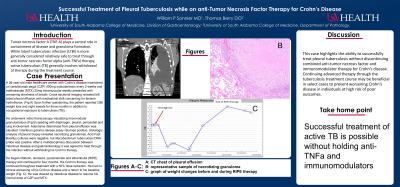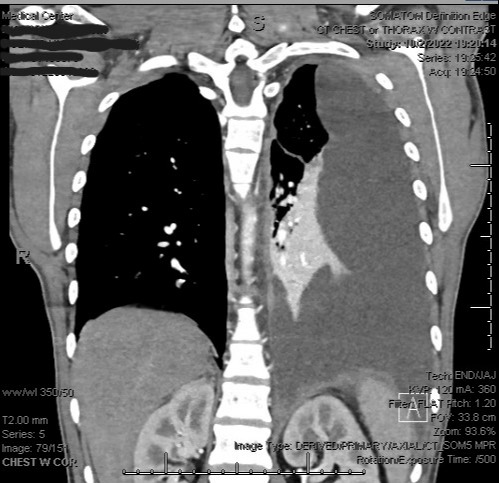Tuesday Poster Session
Category: IBD
P3665 - Successful Treatment of Pleural Tuberculosis While on Anti-Tumor Necrosis Factor Therapy for Crohn’s Disease
Tuesday, October 24, 2023
10:30 AM - 4:00 PM PT
Location: Exhibit Hall

Has Audio
- WS
William Sonnier, MD
University of South Alabama College of Medicine
Mobile, Alabama
Presenting Author(s)
William Sonnier, MD, Travis Berry, DO
University of South Alabama College of Medicine, Mobile, AL
Introduction: Tuberculosis can have atypical and aggressive presentations in patients on anti-Tumor Necrosis Factor therapy.
Case Description/Methods: A 26-year-old male healthcare worker with a history of longstanding Crohn’s disease maintained on certolizumab pegol (CZP) 400mg subcutaneous every 2 weeks and methotrexate (MTX) 25mg intramuscular weekly presented to our facility with worsening shortness of breath. Cross sectional imaging at the time of admission revealed left sided pleural effusion with near total collapse of left lung with mediastinal shift concerning for tension hydrothorax in addition to thickened left pleura and enlarged prevascular lymph node. Upon further questioning, the patient reported 20lb weight loss and night sweats for three months in addition to occupational exposure to tuberculosis (TB). Thoracentesis was performed with effusion returning exudative and further studies pending.
He underwent video thoracoscopy visualizing micronodular granulomatous seeding with diaphragm, pleural, pericardial and lung involvement. Adenosine deaminase from pleural effusion was elevated. Interferon gamma release assay returned positive. Histologic analysis of pleural biopsy revealed necrotizing granulomas. Acid Fast Bacillus cultures were ultimately negative but Mycobacterium tuberculosis DNA probe was positive. After a multidisciplinary discussion between infectious disease and gastroenterology it was agreed to treat through the infection without withholding his Crohn’s therapy.
He began rifabutin, isoniazid, pyrazinamide and ethambutol (RIPE) therapy and continued for four months. His Crohn’s therapy was continued throughout treatment with a 50% dose reduction. He had no clinical worsening of his Crohn’s disease and a return to his baseline weight (Fig. 2). He was cleared by infectious disease to resume his normal dose of CZP and MTX.
Discussion: This case highlights the ability to successfully treat pleural tuberculosis without discontinuing combined anti-tumor necrosis factor and immunomodulator therapy for Crohn’s disease. Continuing advanced therapy through the tuberculosis treatment course may be beneficial in select cases to prevent worsening Crohn’s disease in individuals at high risk of poor outcomes.

Disclosures:
William Sonnier, MD, Travis Berry, DO. P3665 - Successful Treatment of Pleural Tuberculosis While on Anti-Tumor Necrosis Factor Therapy for Crohn’s Disease, ACG 2023 Annual Scientific Meeting Abstracts. Vancouver, BC, Canada: American College of Gastroenterology.
University of South Alabama College of Medicine, Mobile, AL
Introduction: Tuberculosis can have atypical and aggressive presentations in patients on anti-Tumor Necrosis Factor therapy.
Case Description/Methods: A 26-year-old male healthcare worker with a history of longstanding Crohn’s disease maintained on certolizumab pegol (CZP) 400mg subcutaneous every 2 weeks and methotrexate (MTX) 25mg intramuscular weekly presented to our facility with worsening shortness of breath. Cross sectional imaging at the time of admission revealed left sided pleural effusion with near total collapse of left lung with mediastinal shift concerning for tension hydrothorax in addition to thickened left pleura and enlarged prevascular lymph node. Upon further questioning, the patient reported 20lb weight loss and night sweats for three months in addition to occupational exposure to tuberculosis (TB). Thoracentesis was performed with effusion returning exudative and further studies pending.
He underwent video thoracoscopy visualizing micronodular granulomatous seeding with diaphragm, pleural, pericardial and lung involvement. Adenosine deaminase from pleural effusion was elevated. Interferon gamma release assay returned positive. Histologic analysis of pleural biopsy revealed necrotizing granulomas. Acid Fast Bacillus cultures were ultimately negative but Mycobacterium tuberculosis DNA probe was positive. After a multidisciplinary discussion between infectious disease and gastroenterology it was agreed to treat through the infection without withholding his Crohn’s therapy.
He began rifabutin, isoniazid, pyrazinamide and ethambutol (RIPE) therapy and continued for four months. His Crohn’s therapy was continued throughout treatment with a 50% dose reduction. He had no clinical worsening of his Crohn’s disease and a return to his baseline weight (Fig. 2). He was cleared by infectious disease to resume his normal dose of CZP and MTX.
Discussion: This case highlights the ability to successfully treat pleural tuberculosis without discontinuing combined anti-tumor necrosis factor and immunomodulator therapy for Crohn’s disease. Continuing advanced therapy through the tuberculosis treatment course may be beneficial in select cases to prevent worsening Crohn’s disease in individuals at high risk of poor outcomes.

Figure: CT thorax demonstrating pleural effusion
Disclosures:
William Sonnier: Abbvie – Speakers Bureau.
Travis Berry indicated no relevant financial relationships.
William Sonnier, MD, Travis Berry, DO. P3665 - Successful Treatment of Pleural Tuberculosis While on Anti-Tumor Necrosis Factor Therapy for Crohn’s Disease, ACG 2023 Annual Scientific Meeting Abstracts. Vancouver, BC, Canada: American College of Gastroenterology.
